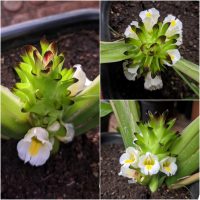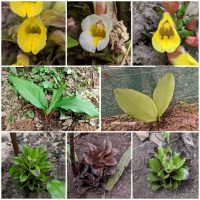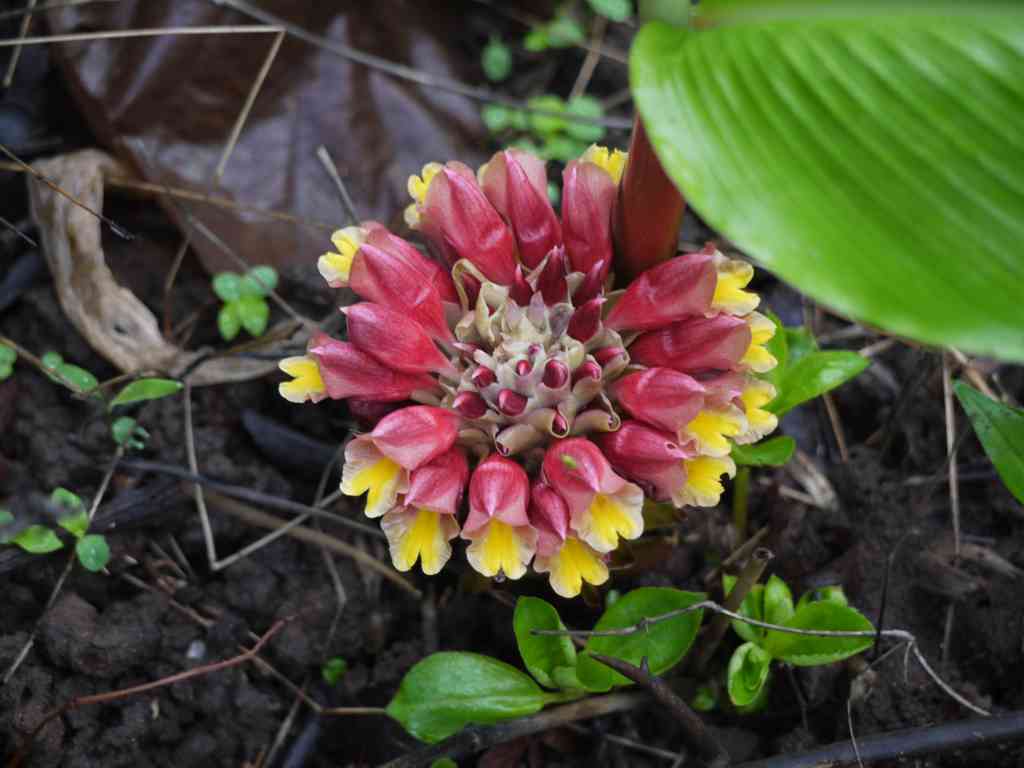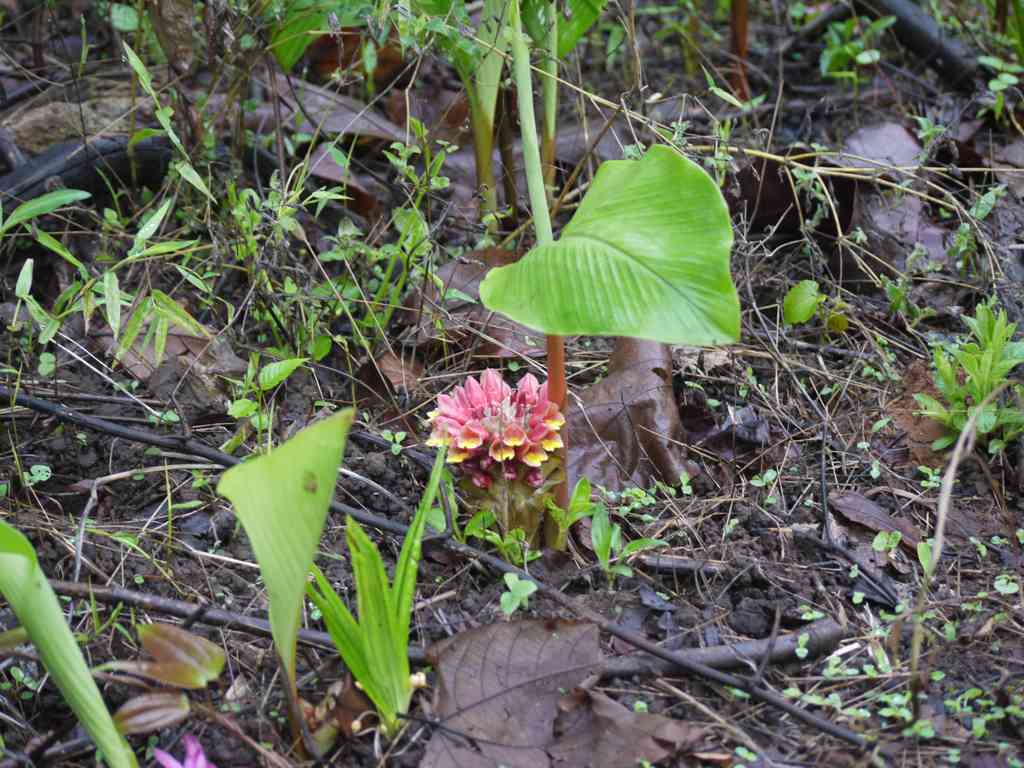|
Curcuma mutabilis Škornick., M.Sabu & Prasanthk., Gard. Bull. Singapore 56: 44 2004.
. India (Kerala) as per POWO; . KER-koo-muh — from the Arabic kurkum, meaning saffron mew-TAB-ill-iss or mew-tah-BIL-iss — meaning, variable . Common name: Changeable Turmeric, Variable curcuma . Endemic to: Western Ghats (of India) . Rhizomatous herb, 10-60 cm tall. Rhizome ovoid without branches, cylindrical to conical, upto 5 x 2.5 cm, deeply buried in the ground, light brown externally, faintly aromatic, fleshy roots end in ovoid root tubers. Root tubers 2-4 x 1-2 cm, distanced 2-15 cm from the main rhizome, light brown glabrous outside, pearly white inside, non aromatic. Leafy shoot 15-60 cm long, leaves 1-2 in the beginning of season, later upto 7 leaves, leaves petiolate. Pseudostem 5-30 cm long, deeply buried in the soil, formed by leaf sheaths and 3-4 sheathing bracts, green or with red tinge and drying up towards the end of season, ligule 3-4 mm long, bilobed, translucent greenish, hairy outside and on margin, petiole upto 20 cm long, first leaves with short petiole, petiole green or with red tinge glabrous or hairy; lamina ovate-elliptical, 14-35 x 7-11 cm, adaxially deep green, sulcate in between, hairy on prominent raised veins and towards margin especially at the upper half of the lamina, hair 0.3 mm long (rarely some individuals are almost glabrous on upper surface), abaxially paler green, usually glabrous, rarely densely velvety pubescent; margin hyaline, translucent white, c. 0.2 mm wide, hairy in apical part and glabrous in distal part of lamina, tip small c. 0.5 cm long, acuminate, densely hairy, base cordate, oblique, midrib green, glabrous. Inflorescence vernal in the beginning of the season, later in the season central. Peduncle 4-20 cm long, 2, 5-8 cm in diameter, glabrous, whitish, light green or with red tinge, peduncle of vernal inflorescence sheathed by bracts, central one hidden in pseudostem. Spike 3.5-15 x 2.5-5 cm, consisted from 6-70 bracts. Coma inconspicious, usually only uppermost 2-3 bracts are sterile and more linear than fertile ones, 2.5-3.5 x 0.7-1.5 cm, light green or with red tinge(sometimes pretty deep), upper side sparsely hairy, lower side glabrous, tips rounded with patch of deep violet mauve colour. Fertile bracts ovate-elliptical with visible parallel veinlets, tip obtuse or slightly acuminate, both sides glabrous, adnate to each other by lower half, 2.5-3.5 x 1.5-2.7 cm, whitish, light green, green or with red tinge which can approach to brown red colour, but always all bracts including uppermost sterile ones have dark violet mauve tip, which is usually larger at upper bracts and less conspicuous at the lower ones. Cinncinus 2-4 flowers. Bracteoles one per flower, 5-7 x 2-4 mm, hyaline, translucent white or with pink or red tinge, almost glabrous or rarely few hairs 0.2-0.3 mm long present. Flowers 4.5-5 cm long, exserted from bracts. Calyx 8-11 mm long, 3-toothed, unilaterally split 3-4.5 mm, deep, translucent white or tinged with pink or dark violet, sparsely hairy. Corolla tube c. 2.5-3 cm long, white, yellowish or yellow at base, towards lobes sometimes tinged with pink, red or violet, glabrous; dorsal corolla lobe c. 1.4-1.8 x 1-1.4 cm, color vary from white, yellowish or yellow, sometimes tinged pink red or deep violet-bluish, mucronate, mucro 1-2 mm long, glabrous, lateral corolla lobes 1.4-1.7 x 0.6-0.8 cm, glabrous, same coloration as dorsal lobe but less intensive, usually overlapping each other by tip portion on ventral side of flower. Lateral staminodes 1.3-1.6 x 1-1.2 cm, usually yellow or yellow with reddish base, less frequently white or white with yellow or reddish base, glandular hairs present on raised middle portion. Labellum 1.4-1.6 x 1.5-1.9 cm, emarginated, split 3-6 mm long (opening more as the flowers are getting old and wilting), yellow or less frequently white, center of deep yellow or yellow, rarely also white, base of labellum usually yellowish, rarely with deep red. Anther spurred, anther thecae whitish, 3.5-4 mm long; filament 3-4 mm long, light yellow, yellow or with deep red tinge, constricted, 3 mm broad at base, 2 mm broad at upper part. Anther spurs 2-2.5 mm long, white or creamy yellowish, pointing upwards. Ovary trilocular, 3-3.5 x 2.5-3 mm, hairy, hair white, 0.3-0.4 mm long, ovules many. Stigma exserted 1-2.5 mm, white, ciliate, 1-1.4 x 0.9-1.1 mm. Epigynous glands 2, creamy yellow, 3-5 mm long, 0.5-0.6 mm in diameter. Fruit dehiscent capsule, spherical, ca. 1 x 1 cm. Seeds 3 x 2 mm, light brown, shiny glabrous, nonaromatic, arrilus translucent white, laciniate, lobes upto 1.5 x 0.7 mm. Flowering and fruiting: May-October
Semi-evergreen forests
Southern Western Ghats (Kerala)
.
… abnormal growth of Curcuma ? : Attachments (3). 9 posts by 6 authors.
Attached are photos of plant, possibly Curcuma species …
wondering whether it is some kind of abnormal kind of growth OR could very well be a proper species.
Sighted this plant at Yeoor Hills (part of Sanjay Gandhi National Park) on 28 JUN 09. This is turmeric. It seem to be very closely related to Curcuma mutabilis I have described from Kerala, so it is interesting to see it from somewhere else. You can call it Curcuma cf. mutabilis for the time being. Was it common there? Is there lot of variability within populations? …, it was not at all commonly found. I did not find another plant in the 5 km walk that day.
Thank you (and …) very much for the ID. What does it mean being called as “Curcuma cf. mutabilis for the time being” by ..? The abbreviation “cf.” is used when the identification is not confirmed.
Araceae, Arecaceae and Zingiberaceae Fortnight: Zingiberaceae: Curcuma mutabilis : 2 posts by 2 authors. Attachments (1). Thanks … for sharing excellent photograph of another species. .
   Curcuma mutabilis: 3 high res. images. Please find attached some pictures of C.mutabilis. I was under the impression I had shared the pictures earlier. It is a highly variable species to the extent that no two individuals resemble each other and variations are in the colour of labellum and staminodes, corolla tube, leaf shape, bract colour and plant height. Location: Nilambur
Habitat: Growing in shade and open areas
Flowering: Lateral inflorescence in May-Jun and central inflorescence in Sep-Oct
|
Disclaimer
1. For any mistake in identification or for becoming efloraofindia e-group member (for contributing towards building of efloraofindia or otherwise), pl. mail to indiantreepix@googlegroups.com or itpmods@googlegroups.com
2. For better viewing of species’ pages, colour scheme & formatting is being followed as: Description of the species, Details of other flora species on the same page, Uses/ harms, Distribution, Abundance/ Location/ Flowering time & date, Habit & habitat, Etymology & pronunciation, Other interesting information, stories etc., Others, Botanical names, Common names, Main point of discussion below, Discussion about Botanical names.
Navigation
- Award for eFloraofIndia
- Colour scheme & formatting
- Copyrights, Permissions, Citations
- eFloraofIndia appreciated
- Names of Plants in India site
- Flowersofindia site
- Posting Guidelines
- For members’ information
- Logo, Tagline, Acronym
- Volunteers required
- ‘Pitamah’ of eFloraofIndia
- ‘अजेय’ ‘Ajey’ of eFloraofIndia
- ‘Saarthi’ ‘सारथि’ of eFloraofIndia
- ‘Jewel’ of eFloraofIndia
- ‘Grassman’ of eFloraofIndia




